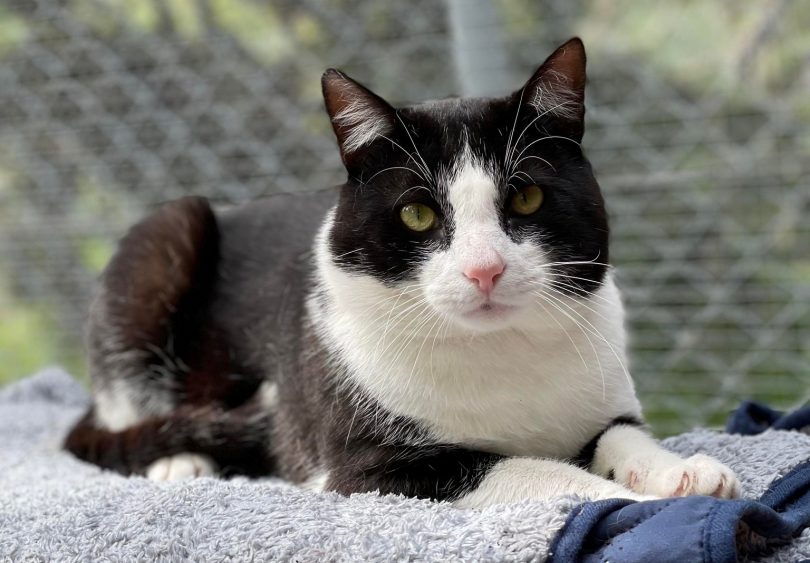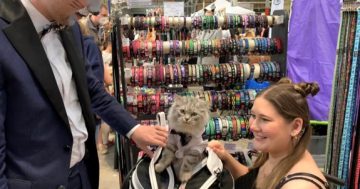
The Canberra Street Cat Alliance (CSCA) says they manage colonies cats in Fyshwick, Hume and Mitchell. Photo: Canberra Street Cat Alliance.
A volunteer-run, self-confessed ‘no-kill’ organisation that says it oversees colonies of ‘unowned’ cats is seeking an exemption from the ACT Government to keep stray cats on the streets.
The Canberra Street Cat Alliance (CSCA) says they manage colonies in Fyshwick, Hume and Mitchell, but these will become illegal when cat containment laws are enacted later this year.
President of the CSCA Vanessa Parton argues their organisation needs the exemption to continue managing the number of stray cats.
“We’re in discussions with the ACT Government to secure an exemption so we can continue doing what we’re doing,” she says.
CSCA currently holds a permit with the ACT Government to undertake their ‘trap, neuter and return’ (TNR) cat management strategy.
CSCA says TNR provides a humane solution to the problem of stray cats in Canberra and the surrounding region, where cats are monitored and trapped before being de-sexed, microchipped and vaccinated. They are then returned to their colony.
The ACT is the only jurisdiction in Australia that allows for TNR. Other states and territories opt instead for sheltering, rehoming or, in some cases, euthanising unclaimed cats.
Ms Parton says that TNR is an “absolutely crucial” part of their work but plays a smaller role in getting as many cats into foster care as they can.
“Last year, we took in 469 cats, only 58 of which were TNR,” she says.
CSCA previously told Region Media that there is “a distinct difference between a feral cat and a community stray”. Colony carers feed the cats and carry out basic health checks. CSCA says that while the cats are generally scared of people, their carers have the same relationship with them as a normal pet owner.
Cat containment laws will come into effect in all new ACT suburbs from July 2022, requiring owners to either keep their cats inside or on a leash. Some leeway will apply for cats owned before this date.
The laws form part of the ACT Cat Plan, released in May 2021 and designed to see all cats eventually owned, wanted and cared for by responsible owners.
At the time, Minister for the Environment Rebecca Vassarotti said the eight-part plan would significantly reduce the harmful hunting of Canberra’s native birds and animals.
“Every year, free-roaming but owned Canberra cats are estimated to prey on 61,000 native birds, 2,000 native mammals, 30,000 native reptiles and 6,000 native frogs,” she said.
“The ACT Government wants to minimise the impacts of domestic cats on native wildlife by reducing the number of feral, unowned and semi-owned cats through more de-sexing, improved domestic cat welfare and management practices, better ways to identify lost cats and reunite them with their owners.”
Ms Parton says this is where everyone agrees.
“At the end of the day, we all want no more street cats. We just have very different philosophies as to how we get there.”
RSPCA ACT CEO Michelle Robertson says that TNR is one of many measures used to control stray cat numbers, but one that isn’t best suited to Australian conditions.
“Based on studies, it is difficult to recommend TNR. This is due to higher rates of kitten morbidity, risk of infectious diseases and welfare considerations. For it to work, it has to be managed really, really well.”
The cats in the colonies are microchipped to the CSCA, which means the CSCA is required under animal welfare legislation to provide medical treatment when required.
This, Ms Robertson says, could implicate the CSCA in any damages to pets or wildlife killed or injured by their cats.
Similar to tactics employed by the CSCA, RSPCA ACT currently traps cats, brings them back to the shelter and to full health before putting them up for adoption.
Ms Robertson says the management of stray cats is an issue that will only be solved when everyone works together.
“We need education and increased community awareness, de-sexing programs – particularly geared for low-income earners, and better laws and regulations.”














